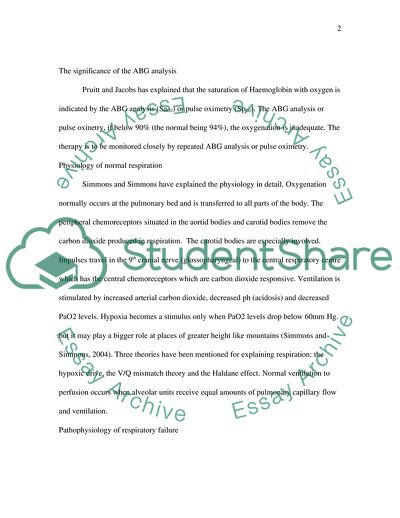
- Home
- Free Samples
- Premium Essays
- Editing Services
- Extra Tools
- Essay Writing Help
- About Us
- Studentshare
- Subjects
- Miscellaneous
- Review of Literature (respiratory nursing)
Review of Literature (respiratory nursing) - Essay Example

- Subject: Miscellaneous
- Type: Essay
- Level: Undergraduate
- Pages: 4 (1000 words)
- Downloads: 0
- Author: nathandietrich
Extract of sample "Review of Literature (respiratory nursing)"
The basic physiology of the exchange of oxygen and carbon dioxide and the transport of oxygen bound to haemoglobin is mentioned in the second article where the authors, Pruitt and Jacobs, who are both teachers for nursing, work with the University of South Alabama. The article by Henderson elaborates the role of oxygen in correcting acute respiratory failure, a condition which could turn fatal, in adults, if caution is not exercised. Respiratory failure is the “failure to maintain adequate gas exchange” and is indicated by an abnormal ABG analysis showing less than 8kPa (Henderson, 2008).
Simmons and Simmons have tried to disprove the hypoxic drive theory which is now “considered obsolete” where the oxygen supplementation for respiratory failure is concerned. Previously it was thought that the hypoxic drive could cause a COPD patient to go in for apnoea, cardiorespiratory arrest and death. However this idea has lost its significance and oxygen therapy is again being advocated strongly. Pruitt and Jacobs has explained that the saturation of Haemoglobin with oxygen is indicated by the ABG analysis (SaO2) or pulse oximetry (SpO2).
The ABG analysis or pulse oxinetry, if below 90% (the normal being 94%), the oxygenation is inadequate. The therapy is to be monitored closely by repeated ABG analysis or pulse oximetry. Simmons and Simmons have explained the physiology in detail. Oxygenation normally occurs at the pulmonary bed and is transferred to all parts of the body. The peripheral chemoreceptors situated in the aortid bodies and carotid bodies remove the carbon dioxide produced in respiration. The carotid bodies are especially involved.
Impulses travel in the 9th cranial nerve (glossopharyngeal) to the central respiratory centre which has the central chemoreceptors which are carbon dioxide responsive. Ventilation is stimulated by increased arterial carbon dioxide, decreased ph
...Download file to see next pages Read MoreCHECK THESE SAMPLES OF Review of Literature (respiratory nursing)
Asthma in Children
Treatment of Acute Respiratory Failure
Respiratory Assessment of Patients Presenting with COPD
Principles of Occupational Health Nursing
An International Outbreak of Pneumonia
Integrating the Sciences and Practice of Nursing
Patient Centered Nursing Care
Endotracheal Suctioning in PICU

- TERMS & CONDITIONS
- PRIVACY POLICY
- COOKIES POLICY